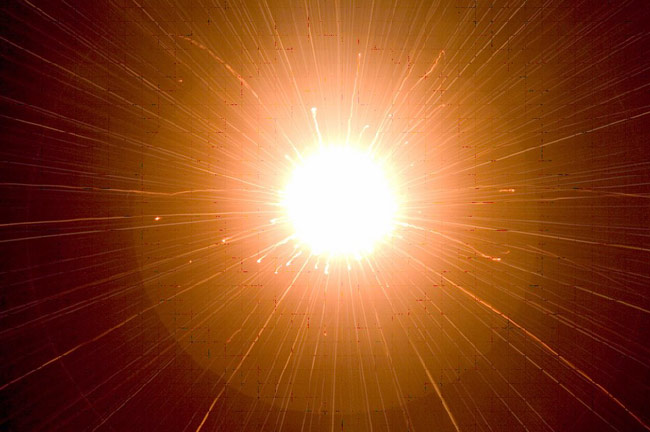100 Explosions Recorded on the Moon

Notso long ago, anyone claiming to see flashes of light on the Moon would be viewedwith deep suspicion by professional astronomers. Such reports were filed under"L" ? for lunatic.
Notanymore. Over the past two and a half years, NASA astronomers have observed theMoon flashing at them not just once but one hundred times.
"They'reexplosions caused by meteoroidshitting the Moon," explains Bill Cooke, head of NASA's MeteoroidEnvironment Office at the Marshall Space Flight Center (MSFC). "A typical blastis about as powerful as a few hundred pounds of TNT and can be photographedeasily using a backyard telescope."
Theimpactor was a tiny fragment of extinct comet 2003 EH1. Every year in earlyJanuary, the Earth-Moon system passes through a stream of debris from thatcomet, producing the well-known Quadrantidmeteor shower. Here on Earth, Quadrantids disintegrate as flashes of lightin the atmosphere; on the airless Moon they hit the ground and explode.
"Westarted our monitoring program in late 2005 after NASA announced plans toreturn astronauts to the Moon," says team leader Rob Suggs of the MSFC. Ifpeople were going to be walking around up there, "it seemed like a good ideato measure how often the Moon was getting hit."
"Almostimmediately, we detected a flash."
Thatfirst detection — "I'll never forget it," he says — came on Nov. 7,2005, when a piece of CometEncke about the size of a baseball hit Mare Imbrium. The resultingexplosion produced a 7th magnitude flash, too dim for the naked eye but an easytarget for the team's 10-inch telescope.
Breaking space news, the latest updates on rocket launches, skywatching events and more!
Acommon question, says Cooke, is "how can something explode on the Moon?There's no oxygen up there."
Theseexplosions don't require oxygen or combustion. Meteoroids hit the moon withtremendous kinetic energy, traveling 30,000 mph or faster. "At that speed,even a pebble can blast a crater several feet wide. The impact heats up rocksand soil on the lunar surface hot enough to glow like molten lava — hence theflash."
Duringmeteor showers such as the Quadrantids or Perseids,when the Moon passes through dense streams of cometary debris, the rate oflunar flashes can go as high as one per hour. Impacts subside when the Moonexits the stream, but curiously the rate never goes to zero.
"Evenwhen no meteor shower is active, we still see flashes," says Cooke.
These"off-shower" impacts come from a vast swarm of natural space junklittering the inner solar system. Bits of stray comet dust and chips off oldasteroids pepper the Moon in small but ultimately significant numbers. Earthgets hit, too, which is why on any given night you can stand under a dark skyand see a few meteors per hour glide overhead — no meteor shower required. Overthe course of a year, these random or "sporadic" impacts outnumberimpacts from organized meteor showers by a ratio of approximately 2:1.
"That'san important finding," says Suggs. "It means there's no time of yearwhen the Moon is impact-free."
Fortunately,says Cooke, astronauts are in little danger. "The odds of a direct hit arenegligible. If, however, we start building big lunar outposts with lots ofsurface area, we'll have to carefully consider these statistics and bear inmind the odds of a structure getting hit."
Secondaryimpacts are the greater concern. When meteoroidsstrike the Moon, debris goes flying in all directions. A single meteoroidproduces a spray consisting of thousands of "secondary" particles alltraveling at bullet-like velocities. This could be a problem because, while theodds of a direct hit are low, the odds of a secondary hit may be significantlygreater. "Secondary particles smaller than a millimeter could pierce aspacesuit," notes Cooke.
Atpresent, no one knows how far and wide secondary particles travel. To get ahandle on the problem, Cooke, Suggs and colleagues are shooting artificialmeteoroids at simulated moon dust and measuring the spray. This work is beingdone at the Vertical Gun Range at NASA's Ames Research Center in Mountain View, CA.
Meanwhile,back at the observatory, the team has upgraded their original 10-inch (25 cm)telescope to a pair of telescopes, one 14-inch (36 cm) and one 20-inch (51 cm),located at the Marshall Space Flight Center in Alabama. They've alsoestablished a new observing site in Georgia with a 14-inch telescope. Multipletelescopes allow double- and triple-checking of faint flashes and improve thestatistical underpinnings of the survey.
"TheMoon is still flashing," says Suggs. Indeed, during the writing of thisstory, three more impacts were detected, bringing the total to 103.
- Potential Danger: Moon Hit By More Space Rocks Than Thought
- Video Player: Moon 2.0: Join the Revolution
- Video Player: Moon meets Rover
Tony Phillips is a professional astronomer and science writer who received a PhD from Cornell University in 1992. He is best known for his authorship of Spaceweather.com. In his career, he has worked as a radio astronomer at Caltech and published more than 100 articles in research journals such as Nature, the Astrophysical Journal, and the Journal of Geophysical Research. Among his astronomical interests are planetary and neutron star magnetospheres, radio storms on Jupiter and cosmic rays.
